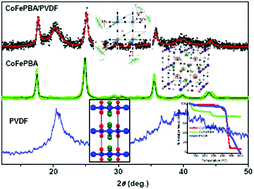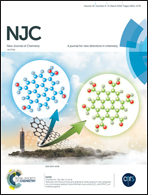Synthesis of CoFe Prussian blue analogue/poly vinylidene fluoride nanocomposite material with improved thermal stability and ferroelectric properties
Abstract
Prussian blue analogues (PBAs) have recently been synthesized in the form of various heterostructures such as core–shell nanoparticles, layered thin films, and nanosized metal/PBAs for their multifunctional properties. However, herein, we report the synthesis of a nanocomposite CoFe Prussian blue analogue (CoFePBA) molecular magnet with a polyvinylidene fluoride (PVDF) polymer. The cyanide (CN) group of CoFePBAs interacts with the CF2 dipole of PVDF to integrate PBAs uniformly into a PVDF matrix. Interestingly, the composite material exhibits a spontaneous polarization which is mainly due to the formation of the β phase of PVDF. However, the value of electric polarization is observed to be higher (∼0.04 μC cm−2) than the spontaneous electric polarization (∼0.02 μC cm−2) of the bare PVDF. The higher value of electric polarization is attributed to the enhanced dipole–dipole interactions between the fluoride atoms of PVDF and the cyanide (–C![[triple bond, length as m-dash]](https://www.rsc.org/images/entities/char_e002.gif) N–) ligand of CoFePBAs. Inclusion of PVDF in CoFePBAs not only helps in improving ferroelectricity, but also improves the thermal stability of the CoFePBAs (up to ∼158 °C), in contrast to the bare CoFePBAs, which are stable only up to ∼65 °C.
N–) ligand of CoFePBAs. Inclusion of PVDF in CoFePBAs not only helps in improving ferroelectricity, but also improves the thermal stability of the CoFePBAs (up to ∼158 °C), in contrast to the bare CoFePBAs, which are stable only up to ∼65 °C.



 Please wait while we load your content...
Please wait while we load your content...